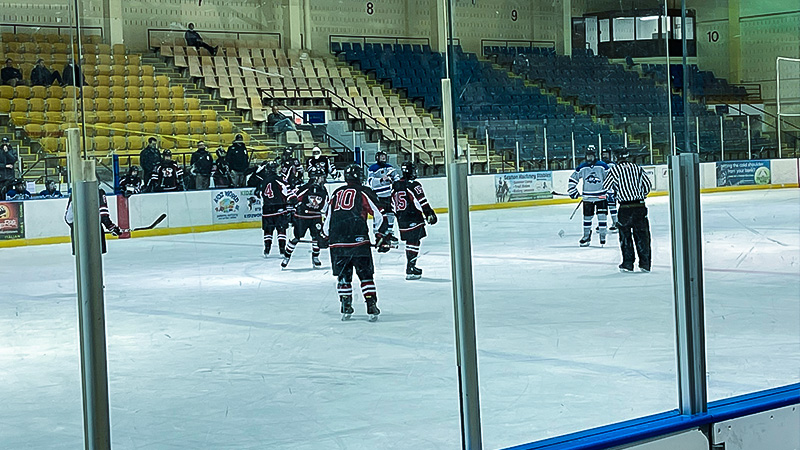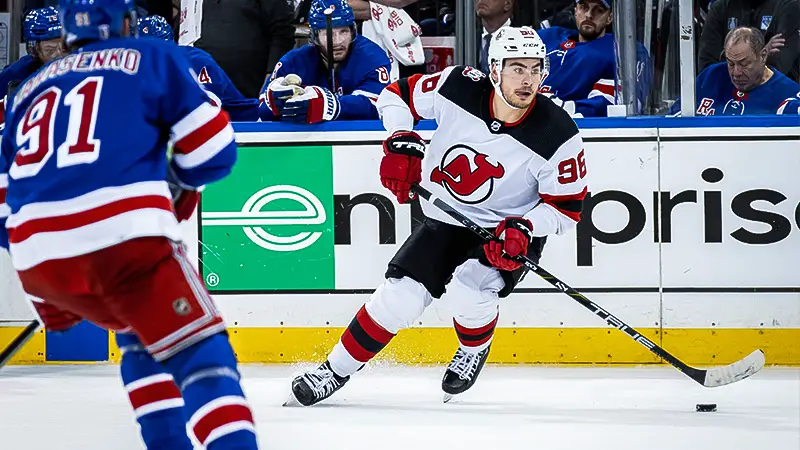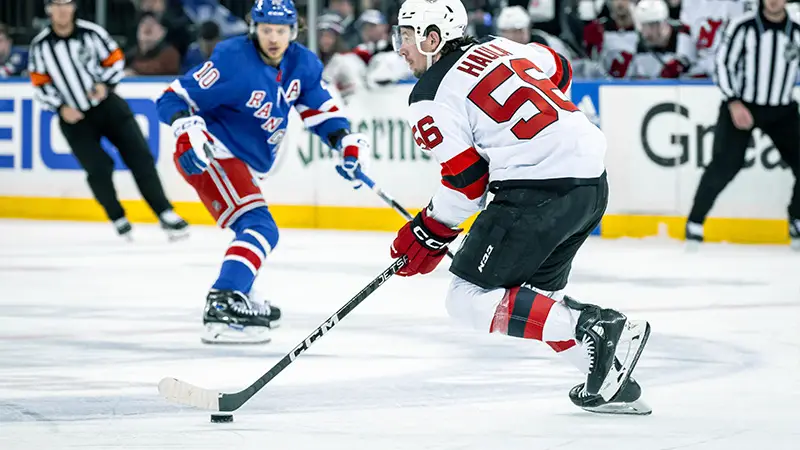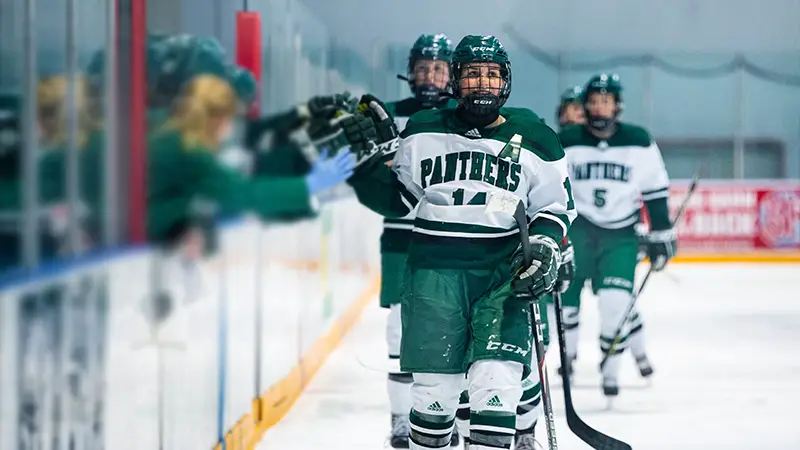Hockey, with its high-speed action and bone-jarring hits, captivates fans worldwide. But have you ever wondered ‘Why does hockey have 3 Periods?’. In this blog post, we will dive into the intriguing history and significance of the three-period format in hockey.
The three-period structure is not a mere convention; it plays a pivotal role in the game’s dynamics. First and foremost, it prioritizes player safety. Hockey is physically demanding, and these breaks allow athletes to recover, reducing the risk of injuries due to exhaustion.
Join us as we explore the strategic intricacies, historical roots, and commercial impact of this time-honored tradition. Whether you’re a seasoned hockey enthusiast or new to the game, understanding why hockey has three periods adds a fascinating layer to your appreciation of this exhilarating sport.

Historical Roots of Hockey Periods
The historical roots of hockey periods can be traced back to the early development of the sport in the 19th century. In its earliest form, hockey was played without formal periods or breaks. Instead, games were often played until one team reached a certain number of goals or until darkness fell.
The introduction of structured periods can be attributed to the need for organized competition. As the sport gained popularity and formal rules were established, it became necessary to divide the game into distinct segments to facilitate play and provide rest for the players.
The concept of three periods in modern ice hockey, each lasting a fixed amount of time, became standard in the early 20th century. This division allowed for a more regulated and manageable game, contributing to the sport’s growth and development into the organized and widely recognized sport we know today.
The historical evolution of hockey periods reflects the sport’s journey from informal beginnings to a structured and professionalized game.
Why Does Hockey Have 3 Periods?
Hockey has three periods primarily for reasons related to player safety, fairness, and practicality:
Player Safety
Hockey is a physically demanding sport that requires intense physical exertion. Having three periods allows players to have regular breaks to rest and recover, reducing the risk of fatigue-related injuries.
This is especially important in a sport where players skate at high speeds, engage in physical contact, and handle a heavy puck.
Fairness and Strategy
Three periods provide a balanced playing field for both teams. Intermissions between periods allow coaches to strategize, make adjustments, and give players time to recuperate. This ensures that each team has an equal opportunity to perform at their best throughout the game.
Commercial Considerations
From a practical standpoint, having intermissions also accommodates commercial breaks, which are crucial for revenue generation through advertising and broadcasting rights. These breaks enable teams and leagues to generate income, which supports the sport’s growth and sustainability.
The three-period format in hockey was adopted to enhance player safety, maintain fairness and strategic planning, and accommodate commercial interests, making it a fundamental aspect of the sport’s structure.
How Do 3 Periods Allow for Player Rotations and Breaks?

Three periods in hockey allow for player rotations and breaks in the following ways:
Line Changes
Hockey teams typically have four lines of forwards and three pairs of defensemen. During the game, these lines take shifts on the ice, typically lasting around 45 seconds to 1.5 minutes, depending on the situation. Between these shifts, players rotate on and off the ice, ensuring that they get regular breaks.
Intermissions
At the end of each period, there is an intermission typically lasting 15 minutes. This extended break provides players with an opportunity to rest, hydrate, and receive any necessary medical attention. It also allows coaches to review strategies and make adjustments.
Timeouts
Teams are also allowed to call timeouts during the game, giving players an additional brief break to regroup or discuss strategies. Each team is usually allowed one timeout per game.
Stoppage of Play
Hockey has frequent stoppages in play due to offside calls, icing, penalties, and face-offs. These natural breaks in the game provide players with moments to catch their breath and prepare for the next play.
By dividing the game into three periods and incorporating these various breaks and rotations, the sport ensures that players have opportunities for rest and recovery, reducing the risk of fatigue-related injuries and allowing them to maintain a high level of performance throughout the game.
Significance of the 3 Periods in Hockey

The significance of the three periods in hockey lies in several key aspects that enhance the game’s structure and overall experience:
Player Safety
Hockey is a physically demanding sport that requires intense effort from players. Three periods allow for regular breaks, reducing the risk of player fatigue, injuries, and burnout. This contributes to the safety and well-being of athletes.
Fair Competition
Three periods create a fair and balanced playing field. They ensure that both teams have equal opportunities for rest and strategy planning. This fairness is essential for maintaining the integrity of the game and giving each team a chance to perform at its best.
Strategic Planning
Intermissions between periods give coaches and players time to evaluate their performance, make tactical adjustments, and discuss game strategies. These breaks are crucial for developing game plans and responding to the opponent’s tactics.
Commercial Considerations
The structured three-period format accommodates commercial breaks, which are essential for generating revenue through advertisements and broadcasting rights. These breaks help sustain the financial health of the sport, supporting its growth and accessibility.
Fan Experience
The three-period format provides fans with a structured and predictable viewing experience. It allows for natural breaks in the action, which can be used for commentary, analysis, and entertainment during broadcasts. This enhances the overall fan experience and engagement with the sport.
Historical Tradition
The three-period system has become deeply ingrained in the tradition and culture of hockey. It reflects the sport’s evolution and development over time, from its early informal origins to the organized and regulated game it is today.
The three periods in hockey are significant for player safety, fair competition, strategic planning, commercial viability, fan engagement, and the sport’s historical heritage.
3 Periods in Women’s Hockey

The use of three periods in women’s hockey is consistent with the format of periods used in men’s hockey and serves the same fundamental purposes, regardless of the gender of the players. These purposes include:
Player Safety
Women’s hockey, like men’s hockey, can be physically demanding, and having three periods allows players to have regular breaks to rest and recover, reducing the risk of fatigue-related injuries.
Fair Competition
Three periods ensure that both teams have equal opportunities for rest and strategy planning. This fairness is essential for maintaining the integrity of the game and giving each team, regardless of gender, a chance to perform at its best.
Strategic Planning
Intermissions between periods in women’s hockey, as in men’s hockey, give coaches and players time to evaluate their performance, make tactical adjustments, and discuss game strategies. These breaks are crucial for developing game plans and responding to the opponent’s tactics.
Commercial Considerations
The structured three-period format accommodates commercial breaks, which are important for generating revenue through advertisements and broadcasting rights. This revenue supports the growth and sustainability of women’s hockey.
Fan Experience
The three-period format in women’s hockey, as in men’s hockey, provides fans with a structured and predictable viewing experience. It allows for natural breaks in the action, which can be used for commentary, analysis, and entertainment during broadcasts, enhancing the overall fan experience.
The use of three periods in women’s hockey is not gender-specific but rather a standard format adopted for the same reasons that apply to men’s hockey: player safety, fair competition, strategic planning, commercial viability, and fan engagement.
NHL Overtime Rule Regarding the 3 Periods
In the National Hockey League (NHL), the overtime rule regarding the three periods is as follows:
Regulation Play
NHL games are typically divided into three periods, each lasting 20 minutes of game time. If a game remains tied after the completion of these three periods, the game goes into overtime.
Overtime Period
Overtime in the NHL is a sudden-death period, meaning the first team to score a goal wins the game. The overtime period is played with a reduced number of skaters on the ice to create more open ice and scoring opportunities.
In regular-season NHL games, overtime is played with three skaters per team (plus a goalie) instead of the usual five skaters per team.
Overtime Format
The NHL uses a modified overtime format where the overtime period starts with a face-off at center ice. The team that scores first during this period is declared the winner. Overtime periods are played at 3-on-3 strength, creating a faster-paced and more exciting brand of hockey with increased scoring chances.
Shootout (If Necessary)
If no goals are scored during the overtime period, the game proceeds to a shootout. Each team selects three skaters to take penalty shots against the opposing team’s goaltender.
If the game remains tied after the initial three shootout attempts per team, it goes to a sudden-death shootout, where teams continue taking shots until one team scores and the other does not.
It’s important to note that the NHL’s overtime rules differ in the regular season and the playoffs. In the playoffs, overtime periods are played at full strength (5-on-5) until a goal is scored, and there are no shootouts. This ensures that playoff games have a definitive winner in overtime.
The NHL’s overtime rule regarding the three periods adds excitement to the game by providing a fair opportunity for both teams to break ties in regular-season games, while playoff games utilize a longer overtime format to determine a winner without resorting to a shootout.
FAQs
Why does hockey have 3 periods?
Hockey has 3 periods primarily for player safety and fairness. It allows players to rest, reducing the risk of injuries due to fatigue. It also ensures both teams have equal chances to strategize and compete, maintaining a level playing field.
How long are the periods in a hockey game?
Each period in a standard hockey game, including the NHL, typically lasts 20 minutes of game time. There are three periods in total.
Can a hockey game end in a tie after 3 periods?
In most professional hockey leagues, including the NHL, a game cannot end in a tie after regulation play. If the score is tied, the game goes into overtime or a shootout, depending on the league’s rules.
Why do teams switch ends after the first period in hockey?
Teams switch ends after the first period to equalize any advantages related to ice conditions or other factors. This ensures that both teams have an equal opportunity to play on each side of the rink.
Are there exceptions to the 3-period format in hockey?
Yes, there are exceptions. In some youth or amateur leagues, games may be played with different period lengths or formats. Additionally, in playoff hockey, overtime periods may continue until a sudden-death goal is scored, deviating from the standard three-period structure.
Wrapping Up
The three periods in hockey, steeped in tradition and adapted for safety and fairness, continue to be a defining feature of the sport. As we’ve discovered, these structured breaks not only safeguard players but also enhance the strategic depth of the game and accommodate commercial interests.
From the icy ponds of the past to the grand arenas of today, the three-period format has remained an integral part of hockey’s enduring legacy.
It’s a testament to the sport’s commitment to its players, fans, and the timeless thrill that is uniquely hockey. So, the next time you watch a game, remember the significance behind those three periods, symbolizing the heart and soul of this beloved sport. Best wishes.




Benjamin Kenyon